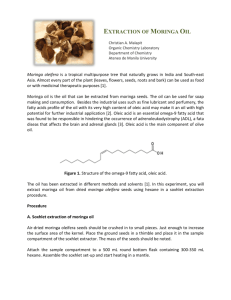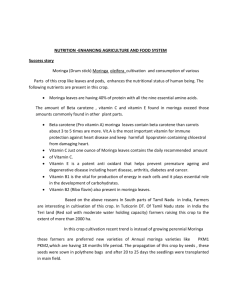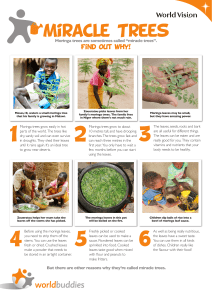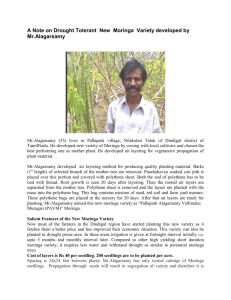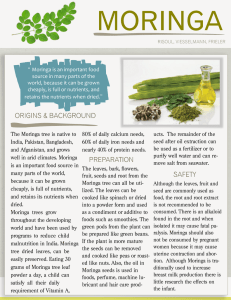Environmental Resources and Conservation Research Programme
advertisement
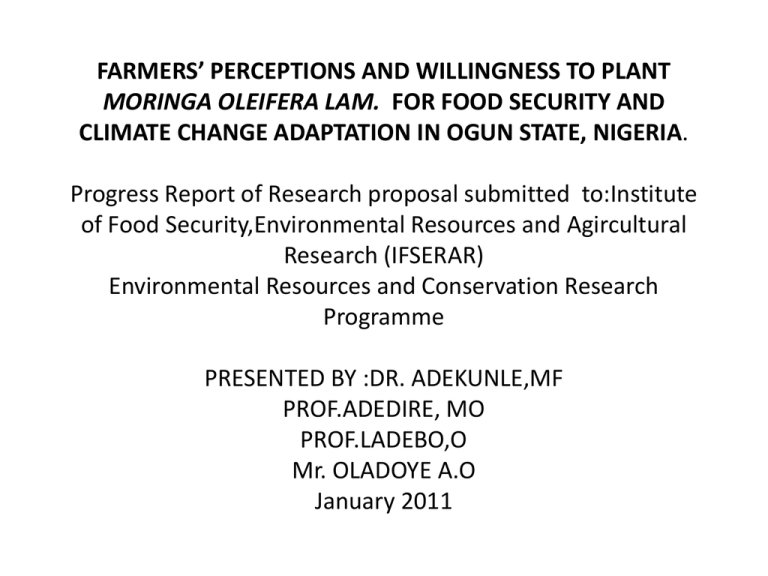
FARMERS’ PERCEPTIONS AND WILLINGNESS TO PLANT MORINGA OLEIFERA LAM. FOR FOOD SECURITY AND CLIMATE CHANGE ADAPTATION IN OGUN STATE, NIGERIA. Progress Report of Research proposal submitted to:Institute of Food Security,Environmental Resources and Agircultural Research (IFSERAR) Environmental Resources and Conservation Research Programme PRESENTED BY :DR. ADEKUNLE,MF PROF.ADEDIRE, MO PROF.LADEBO,O Mr. OLADOYE A.O January 2011 Introduction There has been a clamour for the cultivation and utilisation of lesser known indigenous plant species like Moringa oleifera in farming systems. Moringa, because of its socio-economic, cultural and environmental importance as a drought tolerant plant. while a number of studies have been carried out on the origin, morphology and chemistry of Moringa, little or no efforts have been made to unearth the prevailing socio-cultural perceptions and willingness to adopt innovations on the plant amongst its custodians. Objectives of Study Identify the socio-economics attributes of the farmers in the study area. -Identify their awareness, knowledge and willingness to plant Moringa oleifera -To establish relationship between their perception of Moringa and selected socio economic characteristics. Methodology This study will be conducted in Ogun state. The state lies between latitudes 6o and 8 o N and longitudes 2 o. 31 E and 5o E and covers an area of about 16,400Km2 i.e 1.9% of Nigeria’s land area. The population in homogenous mostly Yoruba speaking with 4 sub-ethnic groups namely Egba, Yewa, Ijebu and Remo. Ogun state has a population of 3.7 million people (NPC, 2006)and predominantly an agrarian society. Further descriptions of the state are in line with Adekunle (2005). The multi-stage stratified sampling techniques will be adopted with random selection of at least a local government (LGA) in each of Egba, Yewa, Ijebu and Remo administrative divisions. There after 5 farming villages will be randomly selected to form the second stage of sampling. Investigation on its prevailing socio-cultural perceptions could accelerate the adoption of the plant and enhance sustainable development especially among the farming populace who are more vulnerable to poverty, malnutrition and climate change related problems. Hence the relevance of this study as it will assist decision makers and planners for development of relevant innovative activities on the plant for subsequent adoption by farmers. Thirty (30) respondents will later be selected randomly in each of the 5 villages in each selected LGAs as shown in Table 1 below. This will sum up to a total of 150 respondents in each LGA selected. Snow-ball techniques will be used to identify crop farmers in each of the selected villages. • The respondents will be interviewed using pre-tested questionnaire across the selected LGAs with the aid of field assistants who will be trained about the subject matter and are familiar with the environment • The questionnaire will be made to address issues such as socioeconomic characteristics of the farmers, farmer’s awareness, knowledge and willingness to plant Moringa and their perceptions of Moringa. This will be complemented with discussions with key informants to probe into some of the issues not properly addressed with structured interviews. • Simple descriptive statistical tools such as frequencies, percentages, mean bar and pie-charts will be used to summarise the data collected. The chi-square and correlation analysis will be used to establish the relationship between the farmers’ perception of Moringa and some of their selected socio-economics characteristics • In order to determine how Moringa is perceived by the farmers, 6 positive and 4 negative validated perceptional statements against a 5-point Likert scale ranging from strongly agree (5), agree (4), undecided (3), disagree (2) to strongly disagree (1) for positive and vice versa for negative perceptions will be administered to the farmers in line with Odeyinka et al, (2007). • Results will be presented in form of tables, chats and figures for discussions and management prescriptions. Table 1.Procedures and scope of sampling. Division LGA No of Villages No of Respondnet Total per LGA Egba ? 5 30 150 Yewa ? 5 30 150 Remo ? 5 30 150 Ijebu ? 5 30 150 5 20 120 600 Result and Discussion • A survey has been carried out to identify study areas for primary data collection. The areas identified so far includes Alabata, Ilugun, Odogbolu, Isoyin and Ayepe. • The instrument of data collection especially the questionnaire has been prepared and Field enumerators and research assistants has been identified, briefed and debriefed about the object and scope. • Field enumerations is near completion and the result will be made available in due course



